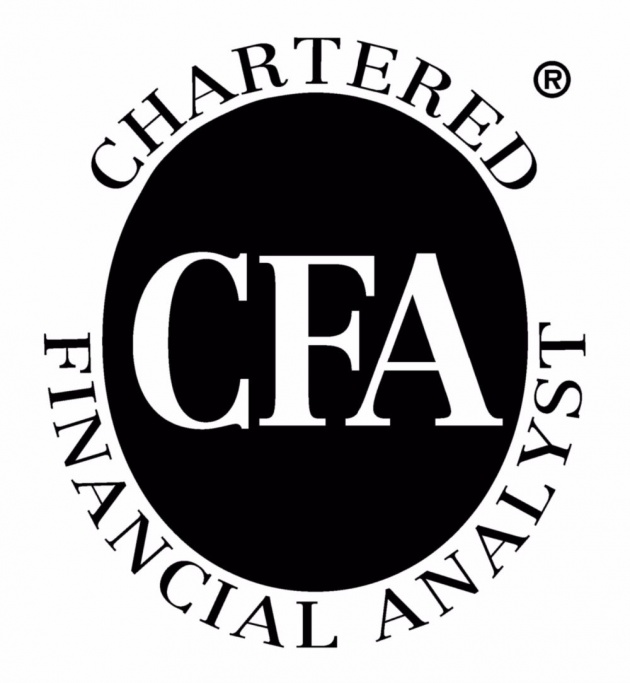Enroll in the CFA Program to begin earning the Chartered Financial Analyst® (CFA) credential, the most respected and recognized investment management designation in the world.
The CFA Program provides a strong foundation of advanced investment analysis and real-world portfolio management skills that will give you a career advantage
- The CFA Program curriculum covers concepts and skills you will use at all stages of your career.
- The self-paced, online format makes it easier for you to continue working while you complete the program.
- Completing the CFA Program shows employers and clients you have mastered a broad range of practical portfolio management and advanced investment analysis skills.
The Chartered Financial Analyst (CFA) Program is a professional credential offered internationally by the American-based CFA Institute (formerly the Association for Investment Management and Research, or AIMR) to investment and financial professionals. A candidate who successfully completes the program and meets other professional requirements is awarded the "CFA charter" and becomes a "CFA charterholder". As of July 2014, there are approximately 120,000 CFA members in 35 countries. The top employers of CFA Charterholders globally are UBS, JP Morgan, Citigroup, Morgan Stanley, and BlackRock.[1]
The CFA exams are widely considered to be difficult,[2][3] with historical pass rates as low as 32%,[4] and pass rates sometimes below 50% for each of the three levels in the same given year. Successful candidates take an average of four years to earn their CFA charter.[5][6] The program covers a broad range of topics relating to investment management,financial analysis, stocks, bonds and derivatives, and provides a generalist knowledge of other areas of finance.

Requirements[edit]
To become a charterholder, candidates must satisfy the following requirements:[7]
- Have four years (48 months) of qualified work experience (or a combination of education and work experience acceptable by the CFA Institute). However, individual level exams may be written prior to satisfying this requirement;
- Complete the CFA Program (mastery of the current CFA curriculum and passing three six-hour examinations);
- Become a member of the CFA Institute and apply for membership to a local CFA member society;
- Adhere to the CFA Institute Code of Ethics and Standards of Professional Conduct.
Independent of any other requirements for becoming a charterholder, the CFA Program takes an average of four years for candidates to complete

Process[edit]
| Year | Level 1 | Level 2 | Level 3 |
|---|---|---|---|
| 2015 Pass % | 42% | 46% | 53% |
| 2014 Pass % | 44% | 46% | 54% |
| 2013 Pass % | 38%/43% | 43% | 49% |
| 2012 Pass % | 38%/37% | 42% | 52% |
| 2011 Pass % | 39%/38% | 43% | 51% |
| 2010 Pass % | 42%/36% | 39% | 46% |
| 2009 Pass % | 46%/34% | 41% | 49% |
| 2008 Pass % | 35% | 46% | 53% |
| 2007 Pass % | 39% | 40% | 50% |
| 2006 Pass % | 40% | 48% | 76% |
| 2005 Pass % | 35% | 56% | 55% |
| 2004 Pass % | 35% | 32% | 64% |
| 2003 Pass % | 41% | 47% | 68% |
| 2002 Pass % | 44% | 47% | 58% |
| Weighted Mean of Pass % | 39.7% | 44% | 57.7% |
The basic requirements for participation in the CFA Program (with or without obtaining the charter) include holding a university degree or being in the final year of a university degree program (or equivalent as assessed by the CFA Institute), or having four years of qualified, professional work experience in an investment decision-making process. To obtain the charter, however, a candidate must have completed a university degree (or equivalent) and four years of qualified, professional work experience, in addition to passing the three exams that test the candidate's knowledge of the academic portion of the CFA program, as discussed below. However, an accredited degree may not be a requirement.[8][9]
Candidates take one exam per year over three years, assuming a pass on the first attempt. Fees as of December 2009 for each exam range from $710 to $955, depending on the date on which the candidate registers to take the exam, plus an additional $400 to $480 for program enrollment for new members. Exams are challenging, with 38% of candidates passing the Level I, 42% passing Level II, and 52% passing Level III exam in June 2012.[10] Level II and III pass rates apply to candidates that must have already passed the prior level(s). From 1963-2012, a total of 950,221 candidates have sat for the Level I exam, with 152,035 candidates ultimately going on to pass the Level III exam, representing a weighted average completion rate of 16%. From 2003-2012, the completion rate was 14%.[10]It could be argued that the completion rates from 2003 to 2012 may be skewed lower due to the presence of recent candidates who have yet to sit for the Level III exam, however the long-term completion rates offer a more unbiased estimate, suggesting that only one out of every seven candidates manages to eventually complete the program.[citation needed]
All three exams are administered on paper on a single day; the Level I exam is administered twice a year (usually the first weekend of June and December). The Level II and III exams are administered once a year, usually the first weekend of June. Each exam consists of two three-hour sessions. Level I has 240 independent, multiple-choice questions—all information required to answer the question is contained in the question. Level II has 120 multiple-choice questions, organized as 20 six-question item sets, each set having its own vignette of facts. To answer each question, the candidate must refer to the vignette as there is insufficient information in the question stem. Level III consists of a session of constructive response, essay-type questions, and a session of 10 six-question item sets as in the Level II exam. On the multiple-choice/item set sections, there is no penalty for wrong answers. For the test, only two models of calculator are allowed (the Hewlett Packard 12C including the HP 12C Platinum, and the Texas Instruments BA II Plusincluding the BA II Plus Professional).[citation needed]
Candidates who have taken the exam receive a score report that is intended to be fairly unspecific: there is no overall score for the test, only a Pass/Fail result, and a range within which his or her performance for each topic area falls: below 50%, between 50% and 70%, and above 70%. Failing candidates are informed of their decile rank within the body of failing candidates. The passing grade for the exams had been defined as 70% of the top percentage of exam papers until 1989; since then, the grading method is not explicitly published and the minimum passing score is set by the Board of Governors after each exam. The Board of Governors reviews the results of the standard setting process and input from psychometricians.[citation needed]
Standard setting is a process that defines the passing score of the exam. The CFA exam uses the modified Angoff method which is a commonly used approach to setting standards for certification and licensure examinations. Subject matter experts review the exam and recommend a minimum passing score for the "just-qualified candidate". The minimum passing scores are presented to the Board of Governors in a report. The Board of Governors is not bound by this recommendation, but does recognize it as a very important information.[citation needed]




